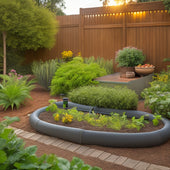
Maximize Space With Rooftop Vertical Gardening Benefits
Share
By adopting rooftop vertical gardening, you can maximize space in urban areas and access numerous benefits. You'll increase crop yield in small spaces, reduce the urban heat island effect, and improve air quality and aesthetics. Additionally, you'll enhance biodiversity and ecosystems, decrease energy consumption, and boost food security and entry. With rooftop vertical gardening, you'll also have the flexibility to customize designs and integrate sustainable practices. As you explore this innovative approach, you'll discover even more advantages and opportunities to transform urban spaces into thriving oases, accessing a world of possibilities for you and your community.
Increased Yield in Small Spaces
By utilizing rooftop vertical gardening, you can enhance your crop yield even in compact, urban spaces with limited horizontal footage. This innovative approach allows you to maximize your space, making the most of every square inch.
To achieve best results, it's important to employ efficient irrigation techniques that deliver water directly to the roots, reducing evaporation and runoff. Selecting the right plants for your vertical garden is also essential, as some varieties are better suited for compact, vertical growth.
For instance, vining plants like tomatoes and cucumbers thrive in vertical gardens, while leafy greens like lettuce and kale are ideal for smaller spaces.
Regular vertical garden maintenance is also crucial, involving tasks like pruning, fertilizing, and monitoring for pests. By optimizing your space and implementing these strategies, you can increase your crop yield significantly, even in the smallest of areas.
With rooftop vertical gardening, you're in control of your harvest, and with the right techniques, you can enjoy a bountiful yield all year round.
Reduced Urban Heat Island Effect
As you implement rooftop vertical gardening in urban areas, you can mitigate the urban heat island effect by providing shade, increasing evapotranspiration, and reducing the amount of heat-absorbing surfaces. This approach is an effective way to integrate green infrastructure into sustainable design, enhancing climate resilience in urban planning.
| Urban Heat Island Effect | Rooftop Vertical Gardening Solution | Benefits |
|---|---|---|
| Increased temperature | Shade provision | Reduced heat absorption |
| Heat-absorbing surfaces | Evapotranspiration | Cooling effect |
| Urban heat islands | Green roofs | Climate resilience |
| Heat-related illnesses | Vegetation cover | Improved health |
Improved Air Quality and Aesthetics
One significant advantage of rooftop vertical gardening is that it can effectively remove air pollutants, such as particulate matter, ozone, and nitrogen dioxide, from the atmosphere, ultimately improving air quality and aesthetics in urban environments.
As you implement rooftop vertical gardening, you'll notice a significant reduction in air pollutants, which contributes to improved health benefits for you and your community. In fact, studies have shown that rooftop gardens can reduce air pollution by up to 20%, leading to improved respiratory health and overall well-being.
Beyond the health benefits, rooftop vertical gardening also fosters community engagement and social impact. By creating a shared green space, you can bring together residents, local businesses, and community groups to work towards sustainable practices. This collective effort not only beautifies urban landscapes but also promotes a sense of community and shared responsibility.
As you cultivate your rooftop garden, you're contributing to a larger movement towards sustainable urban development, which has a profound impact on both local and global environments. By doing so, you're taking control of your environment and creating a healthier, more beautiful space for everyone to enjoy.
Enhanced Biodiversity and Ecosystems
As you design and implement your rooftop vertical garden, you'll create opportunities for urban wildlife habitats to thrive, providing a haven for species that might otherwise struggle to survive in the midst of concrete and steel.
By incorporating native plant species, you'll also support local ecosystems and promote biodiversity.
Additionally, you'll be able to strike a balance with soil microbe populations, fostering a healthy and resilient ecosystem.
Urban Wildlife Habitats
By incorporating rooftop vertical gardens into urban landscapes, you create habitats that support a diverse range of wildlife, from pollinators like bees and butterflies to birds and small mammals.
These rooftop gardens can be designed as bird sanctuaries, providing shelter and food for urban avifauna. Alternatively, they can be optimized as pollinator gardens, featuring plants that attract and nourish essential insects.
Green rooftops, in particular, offer a unique opportunity to restore ecological balance in urban ecosystems. By introducing native plant species and providing habitat diversity, you can support local wildlife populations and promote biodiversity.
Rooftop vertical gardens can also serve as corridors, connecting isolated habitats and allowing species to migrate and adapt. As you design and maintain your rooftop garden, you're not only enhancing local ecosystems but also contributing to the overall health and resilience of urban environments.
Native Plant Species
Incorporate native plant species into your rooftop vertical garden to dramatically boost local biodiversity and ecosystem resilience, as these plants have co-evolved with native wildlife and provide ideal food and shelter.
By choosing native plants, you'll create a haven for local pollinators, such as bees and butterflies, which are essential for plant reproduction. This approach also supports water conservation, as native plants are naturally adapted to the local climate and require less irrigation.
Here are some key benefits of using native plant species in your rooftop vertical garden:
-
Pollinator support: Native plants provide a rich source of nectar and pollen, supporting the local pollinator population.
-
Water conservation: Native plants are adapted to the local climate, reducing the need for excessive watering.
-
Seasonal planting: Plant species that thrive in different seasons, ensuring year-round biodiversity and ecosystem resilience.
-
Soil health: Native plants have co-evolved with local soil microorganisms, promoting healthy soil ecosystems.
-
Ecosystem resilience: Native plants provide habitat and food for native wildlife, supporting ecosystem resilience in the face of environmental challenges.
Soil Microbe Balance
You can further enhance biodiversity and ecosystem resilience in your rooftop vertical garden by maintaining a balanced soil microbe ecosystem, where native plants and microorganisms work together to create a thriving environment. A balanced soil microbe ecosystem is essential for the best nutrient cycling, plant growth, and overall soil health. By promoting microbial diversity, you can create a self-sustaining ecosystem that requires minimal external inputs.
Here's a snapshot of the benefits of a balanced soil microbe ecosystem:
| Benefit | Description | Impact |
|---|---|---|
| Nutrient Cycling | Microbes break down organic matter, releasing nutrients for plants to absorb | Healthy plant growth |
| Soil Structure | Microbes help aggregate soil particles, improving water infiltration and aeration | Increased water retention, reduced erosion |
| Disease Suppression | Beneficial microbes outcompete pathogens, reducing disease incidence | Reduced pesticide use, healthier plants |
| Carbon Sequestration | Microbes help sequester carbon in soil, mitigating climate change | Reduced carbon footprint |
| Ecosystem Resilience | A balanced soil microbe ecosystem can recover quickly from disturbances | Increased ecosystem stability |
Energy Efficiency and Cost Savings
Rooftop vertical gardens reduce the urban heat island effect, thereby decreasing the energy required to cool your building during hot summer months. This means you'll see a significant reduction in your energy bills, which isn't only good for your wallet but also for the environment.
By incorporating rooftop vertical gardens into your building design, you'll reap several energy-efficient benefits, including:
-
Reduced energy consumption: Less energy is needed to cool your building, which leads to significant cost savings.
-
Improved insulation: The garden acts as an additional layer of insulation, reducing heat gain during summer and heat loss during winter.
-
Water conservation: Rooftop gardens can be designed to collect and reuse rainwater, reducing your water consumption and environmental impact.
-
Enhanced building envelope: The garden's soil and plants provide an additional layer of protection against extreme weather conditions, reducing the need for costly repairs and maintenance.
-
Compliance with sustainable practices: By incorporating rooftop vertical gardens, you'll be meeting and exceeding local building codes and sustainable practices, giving you a competitive edge in the market.
Increased Food Security and Access
One significant advantage of rooftop vertical gardens is that they provide a reliable source of fresh produce, directly addressing the pressing issue of food security in urban areas.
You'll have access to nutritious fruits and vegetables right in your backyard, reducing your reliance on industrial agriculture and transportation networks.
This increased food security also fosters community engagement, as rooftop gardens can serve as hubs for neighborhood gatherings, workshops, and educational programs.
By adopting sustainable practices, such as recycling rainwater and using natural pest control methods, you'll minimize your environmental footprint while maximizing your yield.
Rooftop vertical gardens empower you to take control of your food supply, making healthy eating a convenient and affordable option.
As you harvest your crops, you'll be contributing to a more resilient and self-sufficient community.
Versatility and Customization Options
Multiple vertical gardening systems can be integrated into a single rooftop space, allowing for a diverse range of crops to be grown in a small area. This setup enables you to experiment with different creative designs and vertical farming techniques, making the most of your rooftop's potential. With rooftop vertical gardening, you have the flexibility to customize your layout to suit your specific needs and preferences.
Some of the customization options you can explore include:
-
Mixing and matching different types of planters, trellises, and irrigation systems to create a unique setup
-
Incorporating sustainable practices, such as rainwater harvesting and composting, into your gardening routine
-
Designing customized layouts to maximize space and minimize shading
-
Integrating automated systems, such as sensors and timers, to streamline maintenance and care
-
Incorporating educational or recreational spaces, such as seating areas or demonstration gardens, to enhance the overall experience
Frequently Asked Questions
Can Rooftop Gardens Withstand High Winds and Extreme Weather?
You'll want to make sure your rooftop garden can withstand harsh conditions; it's crucial to prioritize wind resilience through secure structural support and regular garden maintenance, as well as weatherproofing measures to protect your investment.
How Do Rooftop Gardens Affect Building Waterproofing and Drainage?
You'll need to address waterproofing concerns by ensuring a secure roofing membrane and proper drainage solutions, such as sloped surfaces and gutters, to prevent water accumulation and damage when installing a rooftop garden.
Are Rooftop Gardens Noisy Due to Irrigation and Wind?
You'll want to take noise concerns into account when designing your rooftop garden, as irrigation systems and wind impact can generate significant sound levels, potentially disturbing occupants or neighbors, so implement sound-reducing measures to minimize disturbance.
Do Rooftop Gardens Require Special Permits or Licenses?
You'll need to research permit requirements and legal considerations before installing a rooftop garden, as local regulations vary, and obtaining necessary permits and licenses is vital to avoid costly fines and penalties.
Can Rooftop Gardens Be Installed on Existing Buildings or Only New Ones?
You can install rooftop gardens on existing buildings through retrofitting, opening up urban agriculture opportunities. This involves evaluating the structure's integrity, ensuring it can support the added weight, and adapting the design to fit the existing architecture.
Related Posts
-

Irrigation Solutions for Raised Bed Planters Made Easy
You can optimize your raised bed planters' irrigation system by understanding the complex interplay between soil type...
-

Irrigation Solutions for Raised Bed Planters Made Easy
You can optimize your raised bed planters' irrigation system by understanding the complex interplay between soil type...
-

Irrigation Solutions for Raised Bed Planters Made Easy
You can optimize your raised bed planters' irrigation system by understanding the complex interplay between soil type...
-

Irrigation Solutions for Raised Bed Planters Made Easy
You can optimize your raised bed planters' irrigation system by understanding the complex interplay between soil type...
-

Irrigation Solutions for Raised Bed Planters Made Easy
You can optimize your raised bed planters' irrigation system by understanding the complex interplay between soil type...
-

Irrigation Solutions for Raised Bed Planters Made Easy
You can optimize your raised bed planters' irrigation system by understanding the complex interplay between soil type...
-

Irrigation Solutions for Raised Bed Planters Made Easy
You can optimize your raised bed planters' irrigation system by understanding the complex interplay between soil type...
-

Irrigation Solutions for Raised Bed Planters Made Easy
You can optimize your raised bed planters' irrigation system by understanding the complex interplay between soil type...
-

Irrigation Solutions for Raised Bed Planters Made Easy
You can optimize your raised bed planters' irrigation system by understanding the complex interplay between soil type...
-

Irrigation Solutions for Raised Bed Planters Made Easy
You can optimize your raised bed planters' irrigation system by understanding the complex interplay between soil type...
-

Irrigation Solutions for Raised Bed Planters Made Easy
You can optimize your raised bed planters' irrigation system by understanding the complex interplay between soil type...
-

Irrigation Solutions for Raised Bed Planters Made Easy
You can optimize your raised bed planters' irrigation system by understanding the complex interplay between soil type...
-

Irrigation Solutions for Raised Bed Planters Made Easy
You can optimize your raised bed planters' irrigation system by understanding the complex interplay between soil type...
-

Irrigation Solutions for Raised Bed Planters Made Easy
You can optimize your raised bed planters' irrigation system by understanding the complex interplay between soil type...
-

Irrigation Solutions for Raised Bed Planters Made Easy
You can optimize your raised bed planters' irrigation system by understanding the complex interplay between soil type...
-

Irrigation Solutions for Raised Bed Planters Made Easy
You can optimize your raised bed planters' irrigation system by understanding the complex interplay between soil type...
-

Irrigation Solutions for Raised Bed Planters Made Easy
You can optimize your raised bed planters' irrigation system by understanding the complex interplay between soil type...
-

Irrigation Solutions for Raised Bed Planters Made Easy
You can optimize your raised bed planters' irrigation system by understanding the complex interplay between soil type...
-

Irrigation Solutions for Raised Bed Planters Made Easy
You can optimize your raised bed planters' irrigation system by understanding the complex interplay between soil type...
-

Irrigation Solutions for Raised Bed Planters Made Easy
You can optimize your raised bed planters' irrigation system by understanding the complex interplay between soil type...
-

Irrigation Solutions for Raised Bed Planters Made Easy
You can optimize your raised bed planters' irrigation system by understanding the complex interplay between soil type...
-

Irrigation Solutions for Raised Bed Planters Made Easy
You can optimize your raised bed planters' irrigation system by understanding the complex interplay between soil type...
-

Irrigation Solutions for Raised Bed Planters Made Easy
You can optimize your raised bed planters' irrigation system by understanding the complex interplay between soil type...
-

Irrigation Solutions for Raised Bed Planters Made Easy
You can optimize your raised bed planters' irrigation system by understanding the complex interplay between soil type...
-

Irrigation Solutions for Raised Bed Planters Made Easy
You can optimize your raised bed planters' irrigation system by understanding the complex interplay between soil type...
-

Irrigation Solutions for Raised Bed Planters Made Easy
You can optimize your raised bed planters' irrigation system by understanding the complex interplay between soil type...
-

Irrigation Solutions for Raised Bed Planters Made Easy
You can optimize your raised bed planters' irrigation system by understanding the complex interplay between soil type...
-

Irrigation Solutions for Raised Bed Planters Made Easy
You can optimize your raised bed planters' irrigation system by understanding the complex interplay between soil type...
-

What's the Ideal Timeline for a Concrete Planter Reno
You'll need to allocate around 6-12 weeks for a concrete planter renovation, broken down into seven distinct phases t...
-

What's the Ideal Timeline for a Concrete Planter Reno
You'll need to allocate around 6-12 weeks for a concrete planter renovation, broken down into seven distinct phases t...
-

What's the Ideal Timeline for a Concrete Planter Reno
You'll need to allocate around 6-12 weeks for a concrete planter renovation, broken down into seven distinct phases t...
-

What's the Ideal Timeline for a Concrete Planter Reno
You'll need to allocate around 6-12 weeks for a concrete planter renovation, broken down into seven distinct phases t...
-

What's the Ideal Timeline for a Concrete Planter Reno
You'll need to allocate around 6-12 weeks for a concrete planter renovation, broken down into seven distinct phases t...
-

What's the Ideal Timeline for a Concrete Planter Reno
You'll need to allocate around 6-12 weeks for a concrete planter renovation, broken down into seven distinct phases t...
-

What's the Ideal Timeline for a Concrete Planter Reno
You'll need to allocate around 6-12 weeks for a concrete planter renovation, broken down into seven distinct phases t...
-

What's the Ideal Timeline for a Concrete Planter Reno
You'll need to allocate around 6-12 weeks for a concrete planter renovation, broken down into seven distinct phases t...
-

What's the Ideal Timeline for a Concrete Planter Reno
You'll need to allocate around 6-12 weeks for a concrete planter renovation, broken down into seven distinct phases t...
-

What's the Ideal Timeline for a Concrete Planter Reno
You'll need to allocate around 6-12 weeks for a concrete planter renovation, broken down into seven distinct phases t...
-

What's the Ideal Timeline for a Concrete Planter Reno
You'll need to allocate around 6-12 weeks for a concrete planter renovation, broken down into seven distinct phases t...
-

What's the Ideal Timeline for a Concrete Planter Reno
You'll need to allocate around 6-12 weeks for a concrete planter renovation, broken down into seven distinct phases t...
-

What's the Ideal Timeline for a Concrete Planter Reno
You'll need to allocate around 6-12 weeks for a concrete planter renovation, broken down into seven distinct phases t...
-

What's the Ideal Timeline for a Concrete Planter Reno
You'll need to allocate around 6-12 weeks for a concrete planter renovation, broken down into seven distinct phases t...
-

What's the Ideal Timeline for a Concrete Planter Reno
You'll need to allocate around 6-12 weeks for a concrete planter renovation, broken down into seven distinct phases t...
-

What's the Ideal Timeline for a Concrete Planter Reno
You'll need to allocate around 6-12 weeks for a concrete planter renovation, broken down into seven distinct phases t...
-

What's the Ideal Timeline for a Concrete Planter Reno
You'll need to allocate around 6-12 weeks for a concrete planter renovation, broken down into seven distinct phases t...
-

What's the Ideal Timeline for a Concrete Planter Reno
You'll need to allocate around 6-12 weeks for a concrete planter renovation, broken down into seven distinct phases t...
-

What's the Ideal Timeline for a Concrete Planter Reno
You'll need to allocate around 6-12 weeks for a concrete planter renovation, broken down into seven distinct phases t...
-

What's the Ideal Timeline for a Concrete Planter Reno
You'll need to allocate around 6-12 weeks for a concrete planter renovation, broken down into seven distinct phases t...
-

What's the Ideal Timeline for a Concrete Planter Reno
You'll need to allocate around 6-12 weeks for a concrete planter renovation, broken down into seven distinct phases t...
-

Inspect and Revive Second-Hand Tools for Planters
When inspecting and reviving second-hand tools for planters, prioritize tools with sturdy builds and functional parts...
-

Inspect and Revive Second-Hand Tools for Planters
When inspecting and reviving second-hand tools for planters, prioritize tools with sturdy builds and functional parts...
-

Inspect and Revive Second-Hand Tools for Planters
When inspecting and reviving second-hand tools for planters, prioritize tools with sturdy builds and functional parts...
-

Inspect and Revive Second-Hand Tools for Planters
When inspecting and reviving second-hand tools for planters, prioritize tools with sturdy builds and functional parts...
-

Inspect and Revive Second-Hand Tools for Planters
When inspecting and reviving second-hand tools for planters, prioritize tools with sturdy builds and functional parts...
-

Inspect and Revive Second-Hand Tools for Planters
When inspecting and reviving second-hand tools for planters, prioritize tools with sturdy builds and functional parts...
-

Inspect and Revive Second-Hand Tools for Planters
When inspecting and reviving second-hand tools for planters, prioritize tools with sturdy builds and functional parts...
-

Inspect and Revive Second-Hand Tools for Planters
When inspecting and reviving second-hand tools for planters, prioritize tools with sturdy builds and functional parts...
-

Inspect and Revive Second-Hand Tools for Planters
When inspecting and reviving second-hand tools for planters, prioritize tools with sturdy builds and functional parts...
-

Inspect and Revive Second-Hand Tools for Planters
When inspecting and reviving second-hand tools for planters, prioritize tools with sturdy builds and functional parts...
-

Inspect and Revive Second-Hand Tools for Planters
When inspecting and reviving second-hand tools for planters, prioritize tools with sturdy builds and functional parts...
-

Inspect and Revive Second-Hand Tools for Planters
When inspecting and reviving second-hand tools for planters, prioritize tools with sturdy builds and functional parts...
-

Inspect and Revive Second-Hand Tools for Planters
When inspecting and reviving second-hand tools for planters, prioritize tools with sturdy builds and functional parts...
-

Inspect and Revive Second-Hand Tools for Planters
When inspecting and reviving second-hand tools for planters, prioritize tools with sturdy builds and functional parts...
-

Inspect and Revive Second-Hand Tools for Planters
When inspecting and reviving second-hand tools for planters, prioritize tools with sturdy builds and functional parts...
-

Inspect and Revive Second-Hand Tools for Planters
When inspecting and reviving second-hand tools for planters, prioritize tools with sturdy builds and functional parts...
-

Inspect and Revive Second-Hand Tools for Planters
When inspecting and reviving second-hand tools for planters, prioritize tools with sturdy builds and functional parts...
-

Inspect and Revive Second-Hand Tools for Planters
When inspecting and reviving second-hand tools for planters, prioritize tools with sturdy builds and functional parts...
-

Inspect and Revive Second-Hand Tools for Planters
When inspecting and reviving second-hand tools for planters, prioritize tools with sturdy builds and functional parts...
-

Inspect and Revive Second-Hand Tools for Planters
When inspecting and reviving second-hand tools for planters, prioritize tools with sturdy builds and functional parts...
-

Inspect and Revive Second-Hand Tools for Planters
When inspecting and reviving second-hand tools for planters, prioritize tools with sturdy builds and functional parts...
-

Inspect and Revive Second-Hand Tools for Planters
When inspecting and reviving second-hand tools for planters, prioritize tools with sturdy builds and functional parts...
-

Inspect and Revive Second-Hand Tools for Planters
When inspecting and reviving second-hand tools for planters, prioritize tools with sturdy builds and functional parts...
-

Inspect and Revive Second-Hand Tools for Planters
When inspecting and reviving second-hand tools for planters, prioritize tools with sturdy builds and functional parts...
-

Inspect and Revive Second-Hand Tools for Planters
When inspecting and reviving second-hand tools for planters, prioritize tools with sturdy builds and functional parts...
-

Inspect and Revive Second-Hand Tools for Planters
When inspecting and reviving second-hand tools for planters, prioritize tools with sturdy builds and functional parts...


